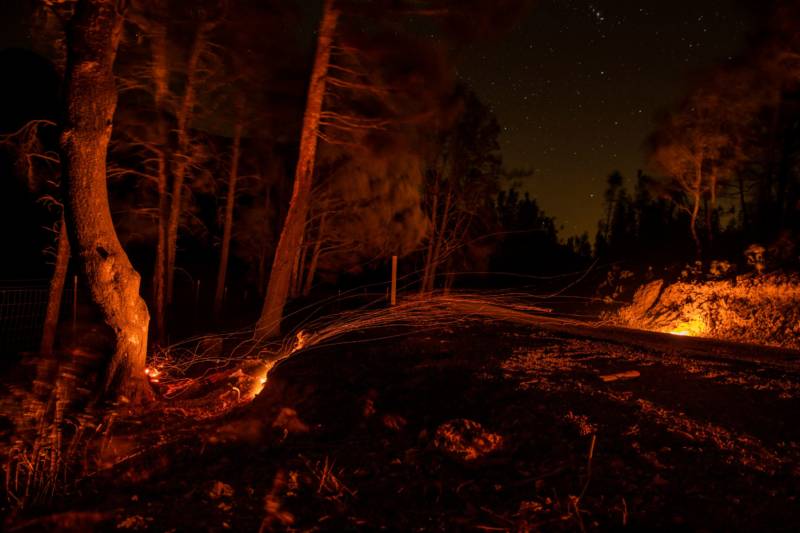As of this writing, California has experienced fewer fire incidents, acres burned, and structures destroyed in 2019 than any other year dating back to 2015, based on data from Cal Fire.
Three people have lost their lives to wildfire this year. The only recent year with fewer wildfire deaths was 2016, when there were none.
Yet wildfires have upended life across California. The Kincade Fire forced the evacuation of more than 180,000 people, a record for Sonoma County.
Meanwhile, PG&E cut power to hundreds of thousands of customers across 29 counties, to try and prevent more fires from starting. Some people went for days without electricity.
So, what’s going on?
No Forest Fires
To start, the fir, pine and other trees that fill the Sierra Nevada and higher elevations of Northern California are not burning much, thanks to a monster snow year and a thorough soaking of May rain.
The Kincade Fire, the year’s largest, has burned more than 77,000 acres of Sonoma County’s chaparral. Sage, shrubs, coastal live oak and madrones spot the grassy woodlands. Sure, there are areas with forest canopies here, but they are not nearly as thick as in the Sierra.
Now that the fire is 100% contained, fire scientists say that strong winds, not forest fuel, drove the Kincade’s growth.
“The Sierra Nevada generally has less fires when we have wet years,” says Jon Keeley, a fire scientist with the U.S. Geological Survey. “But when you get into coastal California, rain isn’t necessarily a good predictor. It’s these extreme autumn winds which ultimately determine what happens.”
Keeley says that the Kincade Fire and other severe fires from the last few years, including the Thomas Fire, Woolsey Fire and the North Bay fires of 2017, were “all blown by extreme wind events.”
The People
Climate change “is probably secondary” as a cause, Oregon State University fire ecologist Meg Krawchuk says about the Kincade Fire.
Other incidents this year underscore California’s wildfire vulnerabilities beyond warming, she adds. “This year’s fires are showing more sensitivity associated with how California is growing, where populations are, building codes, and where people are allowed to live.”
Millions of Californians — about a third of the state’s population — live in what academics call the WUI, or the “wildland-urban interface” (pronounced whoo-ie). Wildfires threaten these neighborhoods, trailer parks and small developments that have sprawled into the forests.
The number of people expected to move into harm’s way is increasing. That means it’s likelier that somebody will ignite a fire when the winds are strong.
Increasingly, humans do not directly start fires. Our stuff does.
“Primarily, power lines,” Keeley says.
“If you look at acreage burned by power line ignitions from 2000 to the present, they burned about half a million acres in California. That’s five times more than burned in the previous 20 years.”
Climate Change
Warming temperatures play an important role in California’s uptick in wildfires.
Heat waves are more common. Snow is melting earlier in the spring. The state is at least three degrees warmer and less rain is falling, report scientists at the federal Environmental Protection Agency. The heat is expanding the area of the state prone to wildfire.
Fire needs three ingredients to burn: ignition, fuel and oxygen.
Warming temperatures are baking conifer forests in the Sierra Nevada and Northern California, increasing the available fuel.
“The strongest effect of that warming is in the summertime forest fires,” says Park Williams, a bioclimatologist at Columbia University’s Lamont-Doherty Earth Observatory.
The arrival of winter rains this year and strong dry winds were “essential ingredients” that likely contributed to the Kincade Fire, Williams says, but climate change may have been a contributing factor, too.
“If you have one of those ingredients, but not the other, then you’re not going to get big fires,” he says. “When both of those switches are on, then it suddenly becomes very relevant that California is about three degrees Fahrenheit warmer than it would be without global warming.”
The Wind
Between Oct. 23 and Nov. 1, the National Weather Service issued three red flag warnings for windy, dry conditions in Sonoma County.
Arriving back-to-back, the offshore winds were a kind of three-act play, with brief interludes in which the gusts calmed for a day before whipping up again and expanding the Kincade Fire.
James Matson battled it in a bulldozer. “The fire was outrunning us,” he recalls. “We couldn’t go as fast as the fire, it would jump ahead of us.”
National Weather Service forecasters in the Bay Area had not seen these conditions before, says David King, one of the meteorologists. “At one point I stood up and asked if anyone has ever put out three red flag warnings in one week, and no one had an answer.”
The wind peaked the night of Saturday, Oct. 26 into Sunday, when gusts ripped faster than 90 miles per hour, in some locations.
The cellphone video above shows the Kincade Fire during one of the wind events. The video was provided by California Department of Corrections and Rehabilitation’s Ben Ingwerson, who led a crew of inmate firefighters in a fight against the wildfire.
Some media outlets incorrectly reported the gusts as “hurricane force.” Scientists measure hurricane intensity by sustained wind speed, not gusts. Regardless, the winds were strong and the event lasted for about 30 hours, which itself, is uncommon (King says these wind storms normally last for about 12 hours).
While the gusts have subsided, the area remains bone dry.
King says measurements of the moisture in the atmosphere — known as precipitable water — tied the record for the lowest October reading ever recorded in the Bay Area.

